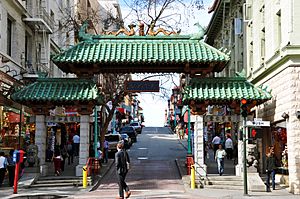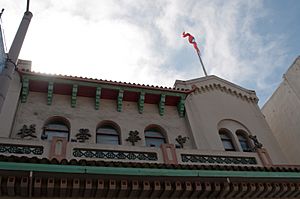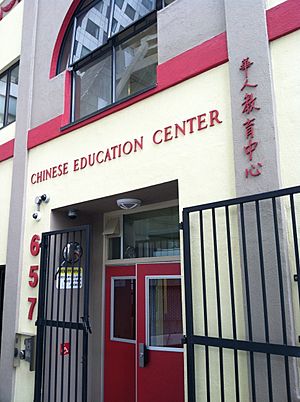History of Chinese Americans in San Francisco facts for kids
| Total population | |
|---|---|
| 150,000 21.4% of total pop. (2014) |
|
| Regions with significant populations | |
| Sunset | 40,000+ |
| Chinatown | 15,000+ |
San Francisco is home to a large and vibrant Chinese American community. As of 2012, about 21.4% of the city's population was of Chinese descent. This means over 150,000 Chinese American residents live there. Chinese Americans are the biggest Asian American group in San Francisco.
San Francisco has the highest percentage of Chinese residents of any major U.S. city. It also has the second largest Chinese American population, right after New York City. The wider Bay Area is about 7.9% Chinese American. Many Chinese Americans also live in nearby cities like Oakland and Santa Clara County. Most Chinese people in San Francisco come from Guangdong province, China and Hong Kong. However, many also have roots in other parts of mainland China and Taiwan.
Contents
History of Chinese Americans in San Francisco
Chinese immigrants first arrived in San Francisco during the California Gold Rush. Many came from the Taishan, Zhongshan, and Guangdong regions of China. They hoped to find gold in the mines across northern California.
Chinatown was a special area in the city. It was one of the few places where Chinese people could own homes. Most early Chinese shopkeepers and workers in Chinatown were men from the Hoisan area. Many Chinese also found jobs with big companies. A famous example is their work on the Transcontinental Railroad for the Central Pacific Railroad.
Early Chinese Immigrants
While many early immigrants were men, Chinese women also began to arrive. The first known Chinese woman to immigrate was Marie Seise in 1848. She worked in a household. Soon after, the Gold Rush began, bringing many people to California. Most Chinese arrivals were sailors from Guangdong Province. They already had connections with Westerners. Few women came at first, as many men planned to return home after making money.
Traveling by sea to the United States offered new chances. But it also had dangers for women. Many were discouraged by the harsh living conditions. Chinese immigrants often traveled on ships like the Pacific Mail Steamship Company and Canadian Pacific Steamship Company. They rode in the steerage section, where food was stored. They often ate rice bowls during the trip.
In 1892, a federal law required immigrants to have a certificate to board. Crowded and unsanitary conditions led to health problems. Diseases like Hookworm and Yersinia pestis were common. These contributed to the Bubonic Plague. The Geary Act of 1892 also made it hard for families to reunite. This law stopped many immigrants from boarding ships.
During the Gold Rush, Chinese men were common in California. But Chinese women were rare. In cities, they were seldom seen in public. Chinatown offered few chances for women to interact with the wider society.
Challenges and Community Support
In the 1870s, the U.S. faced an economic downturn called the Panic of 1873. This led to rising tensions and conflicts in San Francisco. To help the Chinese community, the Chinese Six Companies was formed. This group grew from earlier labor organizations. It gave the Chinese community a united voice. Leaders of these companies were important Chinese merchants. They spoke for the community to businesses and the city government.
Some white citizens, like Pastor Franklin Rhoda, supported the Chinese community. He wrote many letters to local newspapers. By the early 1880s, people called periods of conflict in Chinatown "Tong wars." The San Francisco Police Department even created a "Chinatown Squad."
Immigration Laws and Their Impact
Anti-immigrant feelings led to new laws. The U.S. government passed the Chinese Exclusion Act in 1882. This was the first law to restrict immigration from a single ethnic group. This law, along with the Geary Act, greatly reduced Chinese immigration. It mostly limited new arrivals to single men. Only wealthy merchants' families were exceptions. The law caused Chinatown's population to drop to its lowest in the 1920s.
The 1906 San Francisco earthquake destroyed most of the city, including Chinatown. From 1910 to 1940, Chinese immigrants were held at the Angel Island immigration station. This station was in the San Francisco Bay. Thousands of Chinese immigrants had to pass through Angel Island to enter the U.S. They were often held for months, sometimes even years.
The Chinese Exclusion Act was finally ended during World War II. This happened with the Magnuson Act. China was an important ally in the war. However, strict limits on immigration still remained. The Chinatown Squad was disbanded in 1955. This happened at the request of the Chinese World newspaper. They felt the squad was unfair to Chinese Americans.
New Waves of Immigration
In the 1960s, many working-class Hong Kong Chinese immigrants arrived in Chinatown. Even if they had good jobs in Hong Kong, they often found low-paying work in restaurants and garment factories. This was because they had limited English skills. More Cantonese-speaking immigrants from Hong Kong and Guangdong arrived. This gradually changed the main dialect spoken in Chinatown from Taishanese to standard Cantonese.
Later, the technology industry grew in Silicon Valley. Many immigrants from Mainland China and Taiwan moved to the Bay Area. Many of these new arrivals, especially those who speak Mandarin, live in cities south of San Francisco. These include Cupertino, Sunnyvale, Santa Clara, San Jose, and Fremont.
Growth in the Sunset District
In the Sunset District of western San Francisco, big changes began in the late 1960s. This sped up in the 1980s as more Asian immigrants came to San Francisco. Many of the original Irish American residents moved to other areas. But a good number of Irish Americans still live there.
New, informal Chinatowns have appeared in the Sunset District. You can find them on Irving Street (between 19th and 26th Avenues). There are also Chinese businesses on Taraval Street and Noriega Street west of 19th Avenue. About half of the Sunset District's residents are Asian American. Most of them are of Chinese birth or descent. These immigrants in the Sunset District speak both Mandarin and Cantonese.
Geography of Chinatowns
San Francisco has several Chinatowns:
- Chinatown, San Francisco
- Clement Street Chinatown, San Francisco, known as the "Second Chinatown"
- Irving Street Chinatown, San Francisco, known as the "Third Chinatown"
- Noriega Street Chinatown, San Francisco, known as the "Fourth Chinatown"
There are also Chinatowns and Chinese centers around San Francisco:
- Chinatown, Oakland
- Chinatown, San Jose, California
- Milpitas Square, a Chinese shopping center in Milpitas, California
Cultural Institutions
- The Chinese Culture Center is a non-profit group. It is located between Chinatown and the Financial District.
- The Chinese Historical Society of America started in 1963. It is the first group in the U.S. to save and share the history of Chinese in America. Its museum is in San Francisco's original Chinatown on Clay Street.
Healthcare Services
First Medical Care: Tung Wah Dispensary
The first place for medical care in San Francisco Chinatown was the Tung Wah Dispensary. The Chinese Six Companies built it in 1900 on 828 Sacramento Street. It was named after the Tung Wah Group of Hospitals in Hong Kong. The dispensary had 25 beds. It offered both Western and Chinese medicine. Care was free or low-cost. Its staff included community volunteers and doctors from outside the community. Three American doctors worked there. Chinese American doctors helped with Chinese medicine and translated for the American doctors.
Modern Hospital Development
In 1906, the great San Francisco earthquake destroyed the Tung Wah Dispensary. It was rebuilt in Trenton Alley. However, many people were injured in the earthquake. The dispensary quickly became too crowded. So, they decided to build a modern hospital. They needed $200,000 for this project. They held Chinese pageants to raise money from Chinese Americans and other Americans.
Once they had the money, the San Francisco Board of Supervisors gave permission to build the hospital. Construction began and in two years, on April 18, 1925, the San Francisco Chinese Hospital (東華醫院) opened. It is the only Chinese-language hospital in the United States. The Asian Aids Project (AAP) started in 1987. It helps fight the AIDS epidemic in the Asian community, including Chinese Americans.
Education Opportunities
In San Francisco, you can find:
- The Chinese American International School
- Cumberland Chinese School
- North Valley Chinese School
- Mei Jia Chinese Learning Center
- Alice Fong Yu Alternative School
Around San Francisco, there are also schools:
- Palo Alto Chinese School in Palo Alto teaches both Mandarin and Cantonese.
- The Shoong Family Chinese Cultural Center in Oakland is a main Chinese-language school in the East Area.
- Contra Costa Chinese School is in Pleasant Hill.
- The North Valley Chinese School in Milpitas and San Jose Chinese school serve the greater San Jose area.
- The Redwood Empire Chinese Center's Chinese school in Santa Rosa serves the North Bay.
Media and News
- The Epoch Times (大紀元時報) newspaper has an office in San Francisco. It is based in New York but read worldwide.
- The Hong Kong-based newspaper Sing Tao Daily (星島日報) also has an office in San Francisco.
- The Chinese-American newspaper World Journal (世界日報) has an office in Millbrae.
- KTSF is a television station that broadcasts in Chinese.
Transportation
- Previously, the Taiwanese airline China Airlines ran a bus service. It went to San Francisco International Airport from Milpitas and Cupertino.
Cultural Events
- The Chinese New Year Parade in San Francisco happens every Chinese New Year. It is celebrated in Chinatown. This is the biggest Chinese New Year event in North America.
- The Taiwanese American Cultural Festival started in 1993. It is held in Union Square, San Francisco every May.
Notable People
- Francis Chan, preacher
- Carmen Chu, politician
- Sandra Lee Fewer, politician
- Edsel Ford Fong, waiter at Sam Wo
- Heather Fong, former Chief of San Francisco Police Department
- Alex Gong, kickboxer
- Ed Jew, politician
- Fred Lau, former Chief of San Francisco Police Department
- Bruce Lee, actor, born in Chinatown
- Ed Lee, former Mayor of San Francisco
- Walter U. Lum, activist
- Eric Mar, politician
- Gordon Mar, politician
- Betty Ong, American Airlines Flight 11 flight attendant
- Rose Pak, community organizer
- Amy Tan, author
- Katy Tang, politician
- Phil Ting, politician
- Alex Tse, screenwriter
- Ali Wong, comedian
- Martin Wong, artist
- Willie "Woo Woo" Wong, basketball player, who a playground in Chinatown is named after
- Leland Yee, politician
- Norman Yee, politician




